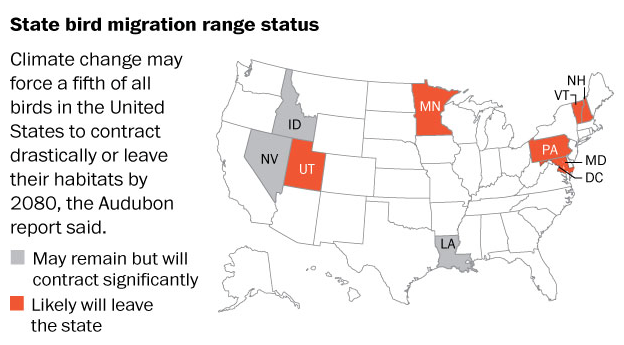The National Audubon Society’s Birds and Climate Change Report is something of a data bonanza. The report uses three decades of citizen-science observations to understand how climate change is affecting bird populations. Ultimately, it presents a model for how over 588 bird species' ranges may change by the end of the century.
We’ve presented this data to you as a series of future range maps—one for each of the 314 most at-risk species, showing how the birds’ winter and summer ranges could shift. However, it is our hope that other organizations will take advantage of this data and use it in unique ways.
Already, several news organizations have illustrated the troubling implications of the Audubon Report. We hope this is just the beginning.
National Geographic: Climate Change May Put Half of North American Birds at Risk of Extinction
National Geographic has selected 10 species and illustrated how some of their ranges will shift between 2000-2050. In true NatGeo fashion, they’ve also created some stunning visuals to remind us all how spectacular some of these birds are.
The New York Times, Climate Change Threatens to Disrupt the Ranges of Birds
Along with their story, the Times’ data-visualization team shows a frightening overview of how dramatically some bird species’ ranges could shrink by 2080.
Check out these, and over 70 other birds whose ranges will shrink by at least 50 percent by 2080, here.
They’ve also pulled together some range maps to highlight how most ranges will head north in the coming decades.
Washington Post: Migration destination unknown
In addition to the Post’s story on the report, the paper also points out that nine states are likely to lose their state birds by 2080.
Wired’s MapLab: New Maps Show Where Birds Will Fly as Earth’s Climate Changes
Wired’s Nick Stockton decided to see how the Bald Eagle and the Turkey Vulture will do under the climate change projections. While the Bald Eagle is expected to lose quite a bit of current climatic range, the Turkey Vulture will actually gain potential climate-suitable range as global warming continues.
2020 Projection:
2050 Projection:
Compare the 2020 estimate to 2080. You can see how the Bald Eagle’s range starts to become sparser while the Turkey Vulture gains ground. The ranges also begin to overlap, meaning that Turkey Vultures and Bald Eagles—both carrion feeders—could become competitive with each other.
Los Angeles Times, Projected changes to bird habitats by 2080
Birds with ranges big and small will suffer the effects of climate change, the graphic from the L.A. Times shows:
Time, See the Effects of Climate Change in 3 Birds
Time drives home the fact that climate change is already affecting birds and their habitats. Dave Johnson and Alexander Ho made use of years of Christmas Bird Count data to show how three bird species are already moving north in response to climate change. They've mapped this shift for the American Black Duck, Pine Siskin, and Peregrine Falcon from 1973-2013.
For example, the American Black Duck used to be most abundant in the midwestern and mid-Atlantic states in 1973, but by 2013, peak abundance had moved to New England and parts of Canada.
For Audubon, this is just the beginning. You can see the climatic range maps for the 314 most at-risk bird species already, but there are many more stories this data can tell in the future.
Update:
On October 7, the Audubon Climate Report was honored with a Breakthrough Award from Popular Mechanics. In its tenth annual Breakthrough Awards, Popular Mechanics focused on acheivements that have an immediate impact on culture.
The award recepients will be featured in the November issue of Popular Mechanics, and the online story already shows a great visual take on the report. Data visualizers there showed how five common birds will lose climate-suitable range between 2000 and 2080.
Popular Mechanics, Two Maps, One Serious Threat to America's Birds
































